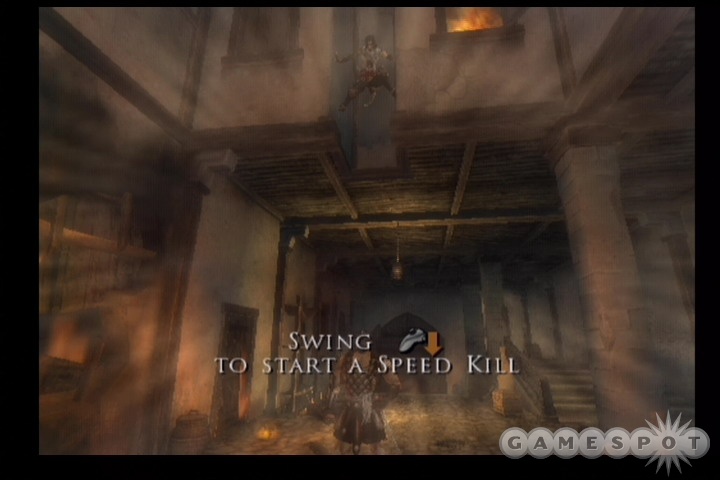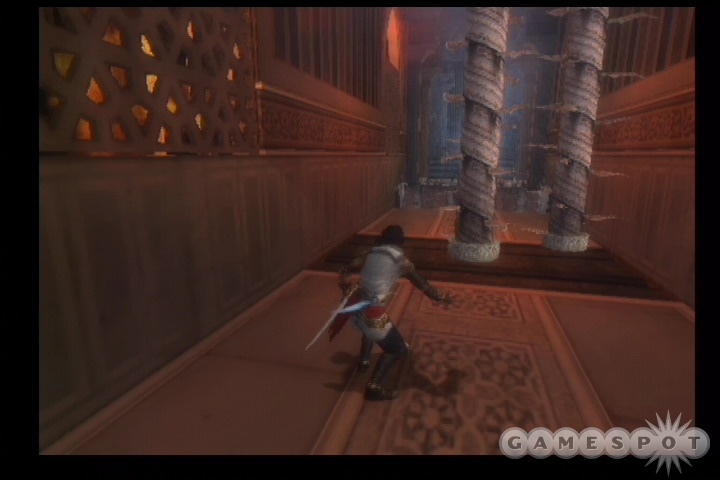In the same way that Ubisoft converted Prince of Persia: Warrior Within to Prince of Persia Revelations for the PlayStation Portable, so too has it released an updated version of Two Thrones for the Wii and PSP with Prince of Persia Rival Swords. Rival Swords retains the essence of what made Two Thrones such a great game in 2005. But rereleasing a game at full price a year and a half after the original doesn't come without expectations, and the added motion-sensing controls do little to justify the lack of a graphical update or the omission of meaningful extras.

Rival Swords/Two Thrones is the conclusion of the Sands of Time trilogy, but the homecoming hasn't gone down according to the Prince's plan. Instead of a sedate life spent getting fat and carousing with the Empress of Time, he finds Babylon burning, a foe once defeated returning immortal, and some maniacal madman installing wicked-confusing elevator systems throughout his city. Vexing for sure, made all the worse when his charge is stabbed in the gut and he inadvertently turns himself into a sand demon. Turns out, using magic to mess with space-time has a nasty way of coming full circle to kick you in the teeth, so by rescuing the Empress from her fate in Warrior Within, the Prince effectively negated his actions in the trilogy's first game, The Sands of Time. What this means is that the Vizier was free to enact his plans of world domination, and, after sidestepping a few plot holes, he promptly does. So, after joining forces again with an old ally for the first time, you're off to rectify your actions by bouncing around all nimbly-bimbly and skewering creeps with a blade--two skills the Prince happens to excel at.
By interfering with the Vizier's machinations, the Prince infects himself with enchanted sand. The power of the sands manifests itself in the form of the Dark Prince, a decidedly sketchy alter ego of the Prince that you'll occasionally morph into, complete with razor-sharp chains encircling his forearms and phosphorescent tattoos etched onto his blackened skin. Along with the new bod comes a new consciousness, which takes up residence in the Prince's head in a schizophrenic fashion. As the Dark Prince, your lethality is greatly enhanced, letting you eviscerate your enemies with a twirl of that enchanted razor wire. The drawback to this nearly unlimited power is that your life essence slowly ebbs away, though it can be fully replenished by picking up the sand charges that are liberally spread throughout the game. Having your life deteriorate certainly adds a sense of urgency to your actions and can increase the game to a near-frenetic pace, as you are pushed through puzzles and forced to find and bust up sand demons or jars of sand so as to avoid becoming dust in the wind yourself.
The ability to manipulate time plays a prominent role in Rival Swords. As you progress through the game, you'll accrue sand charges by either killing enemies or smashing jars, baskets, or what have you. By and large, these sand charges will be converted by your newly reacquired Dagger of Time (first seen in the now-defunct Sands of Time) into recalls, which are essentially do-overs that let you rewind time to either have another go at hitting a jump or undoing a devastating combo that some goon has just inflicted upon you. Timeliness is a virtue, however, as you'll only be able to rewind time up to a certain point, indicated by a bar nestled in among your other vitals. The dagger eventually acquires other attributes, such as the ability to slow down time and to massacre several enemies at once, which both have their uses. One of the major setbacks to the game is the way that sand charges act as a crutch for the Prince, often trivializing would-be difficult encounters. While this does help you burn through the game, it also goes a long way in making for sloppy gameplay, as it never really encourages you to think before you leap or become anything more than proficient with the Prince's extensive combat capabilities.
In much the same vein as Sands of Time and Warrior Within, the Prince's primary concern is running, jumping, swinging, sliding, and scurrying his way from one precarious perch to another. And in a potentially make-or-break decision, Ubisoft mostly sidelined the Wii's motion-sensing controls in favor of the more traditional, and precise, analog controls. So you'll move the Prince around with the Nunchuk's analog stick, jump with the A button, run along walls with the B button, trigger your sand powers with the C button, and so on. As long as you're accustomed to having your hands a foot apart instead of three inches, the Prince's resourceful method of travel will feel as natural as it does in any other recent Prince of Persia game. Camera controls are the only motion-sensing feature that will factor in here. To spin the camera, you roll the remote right or left. The camera is responsive, though it is a bit quirky. For one, the remote needs to be very close to exactly parallel to the ground to register well. The other quirk is that if you roll it farther than 90 degrees, the camera will stop rotating. It takes a bit of getting used to, and with a little more leniency, it'd be a mostly ideal way to rotate the camera. If defying Wii innovation brings you joy, you can also use the D pad to control the camera, but with the close proximity of the buttons, it can be awkward trying to hop about and adjust the camera.
Where the Wii's controls do play a prominent role is in combat, which is fine because combat does not play a prominent role in Rival Swords. Standing between you and the Vizier is a small army of supersoldiers who are hell-bent on seeing you to an early grave. Cutting them down is simply a matter of slashing downward with the Wii Remote and Nunchuk, where the remote corresponds to your dagger and the Nunchuk to your offhand weapon. New to the Prince's repertoire is the speed kill, which can be activated when you successfully sneak up on an enemy. When the onscreen indicator flashes, you simply swipe with the Nunchuk to initiate the sequence, and then swipe with the remote when your dagger flashes blue to quickly and brutally end the life of a foe. Combat alternates between feeling like you're beating a drum and waving your hands like an idiot pretending to know karate. But, like the camera controls, the action is responsive, and though it'll be more difficult to directly control the Prince's attacks than it was using a traditional gamepad, you'll still have some control over rattling off stylistic combos. Of course, spastically thrashing about also works well.
Rival Swords looks, at best, as good as it did on the Xbox nearly a year and a half ago, and certain technical elements actually look worse. Of course, Two Thrones looked excellent for its time, so that's not to say that Rival Swords also doesn't have its moments. The scale of your environments is large, and the Prince's route often leaves him suspended several hundred (if not several thousand) feet in the air. These heights grant a wonderful view of the city and its surroundings, even if those surroundings happen to be ablaze and reduced to rubble. However, the level of detail looks low-res by today's standards, on both character models and the cityscape, and the game has a washed-out, fuzzy look on the whole. In addition to occasional slowdown and frame rate issues, you'll notice a lot more clipping than in Two Thrones; it can be distracting to see the Prince's hair puncturing his cheek or his hands sinking into solid stone. By no means does Rival Swords stretch, or even test, the Wii's graphical limits.

Likewise, the sound is mostly carried over from the Two Thrones, and it sounds as good as it did in that game. A dramatic orchestral score complements some uniformly excellent voice acting, and the game's sound effects are top-notch. The Wii version of Rival Swords has exponentially fewer sound anomalies than the PSP version, though the demon in your head will, on occasion, frantically cry out for you to stab somebody in the eye while you're in an empty corridor--of course, he is insane.
Fundamentally, Prince of Persia Rival Swords is a good game. The question, though, is whether Rival Swords is worth playing over the GameCube version of Two Thrones, which by this time is only $20. There's some added content that mostly equates to a few extra buzz saws lining the walls, so it really comes down to whether the motion controls are worth $30, which they aren't. In fact, the most that can be said for the motion controls is that they stay out of the way. In all other regards, Rival Swords is the same game as Two Thrones, so you'd be much better served just picking up the older version and squandering the $30 you saved on some kind of hardcore Prince of Persia action figure.